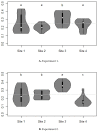Attractiveness and Specificity of Different Polyethylene Blue Screens on Stomoxys calcitrans (Diptera: Muscidae)
- PMID: 32867238
- PMCID: PMC7563190
- DOI: 10.3390/insects11090575
Attractiveness and Specificity of Different Polyethylene Blue Screens on Stomoxys calcitrans (Diptera: Muscidae)
Abstract
Stomoxys calcitrans is considered as a major pest of livestock worldwide. Insecticides have been extensively used to control this pest but resistance to these chemical compounds is now reported in many countries. Therefore, a more sustainable and efficient control is needed. Seven different types of blue screens, with reflectances around 460 nm, were tested during summer 2016 in southwestern France to evaluate their attractiveness and their specificity for stable flies. Height of the screen and orientation (east or west) of a blue screen were also considered. High levels of S. calcitrans captures were recorded during this study (from 141 to 7301 individuals per blue screen and per day) whereas the numbers of tabanids and pollinator insects remained extremely low (less than 10 individuals per screen and per day). No significant difference in attractiveness has been shown between the different types of blue screens. The lower half of the blue screens caught significantly more stable flies (70%) than the higher half (30%). The "east" side of the screen attracted 60% of stable flies but this was not significantly different from the west side. These results are highlighting the interest in these blue polyethylene screens for controlling stable flies in cattle farms, in comparison with more expensive blue fabrics.
Keywords: control; stable fly; trapping; visual target.
Conflict of interest statement
The authors declare that they have no conflicts of interest.
Figures





Similar articles
-
Comparison of blue cotton and blue polyester fabrics to attract hematophagous flies in cattle farms in Thailand.J Vector Ecol. 2020 Dec;45(2):262-268. doi: 10.1111/jvec.12397. J Vector Ecol. 2020. PMID: 33207049
-
Insecticide resistance in stable flies (Stomoxys calcitrans) on dairy farms in Germany.Parasitol Res. 2019 Sep;118(9):2499-2507. doi: 10.1007/s00436-019-06400-z. Epub 2019 Jul 30. Parasitol Res. 2019. PMID: 31363921
-
A Comparison of Attractants for Sampling Stomoxys calcitrans (Diptera: Muscidae) on Dairy Farms in Saraburi Province, Thailand.J Econ Entomol. 2016 Apr;109(2):942-6. doi: 10.1093/jee/tov334. J Econ Entomol. 2016. PMID: 26614795
-
A Historical Review of Management Options Used against the Stable Fly (Diptera: Muscidae).Insects. 2020 May 15;11(5):313. doi: 10.3390/insects11050313. Insects. 2020. PMID: 32429109 Free PMC article. Review.
-
Vector control by removal trapping.Am J Trop Med Hyg. 1994;50(6 Suppl):126-33. doi: 10.4269/ajtmh.1994.50.126. Am J Trop Med Hyg. 1994. PMID: 8024078 Review.
Cited by
-
Colour Preference of the Deer Ked Lipoptena fortisetosa (Diptera: Hippoboscidae).Insects. 2021 Sep 19;12(9):845. doi: 10.3390/insects12090845. Insects. 2021. PMID: 34564285 Free PMC article.
-
An Integrated Pest Management Strategy Approach for the Management of the Stable Fly Stomoxys calcitrans (Diptera: Muscidae).Insects. 2024 Mar 25;15(4):222. doi: 10.3390/insects15040222. Insects. 2024. PMID: 38667353 Free PMC article.
References
-
- Hogsette J.A., Ruff J.P., Jones C.J. Stable fly biology and control in northwest Florida. J. Agric. Entomol. 1987;4:1–11.
Grants and funding
LinkOut - more resources
Full Text Sources

